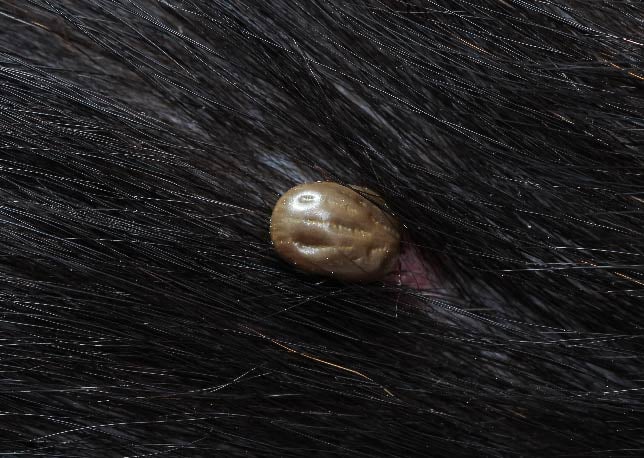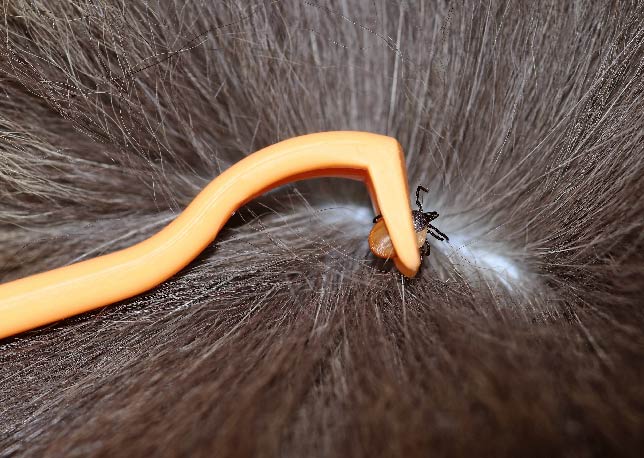23rd March 2022
Ticks on dogs – identification & treatment
As a dog owner, it’s likely you’ll come across a tick at some point in your pooch's lifetime. So, it's essential to know how to safely remove ticks, as well as understanding the potential risks if ticks aren’t removed.
While ticks seem pointless, they do have a purpose in the ecosystem because they’re a food source for other species, like magpies and Guineafowl.
Unfortunately, your dog can be a perfect feeding ground for these parasites. Here’s what you need to know about these arachnids and the diseases they carry…
What do ticks look like?
Ticks vary in shape, colour, and size – but they have a flattened, oval-shaped body before feeding and a plump, rounded body once fed.
When they’re unfed, ticks are the size of a sesame seed, then grow to the size of a coffee bean when engorged (full) with their host’s blood.

When are ticks active?
Ticks are most active from March to October, though you might come across them in the winter months, too.
Because ticks are at risk of drying out, they prefer moist and humid environments; choosing to live in grass, bushes, shrubs, and foliage.
How do ticks get on to your dog?
During their wait for a host, ticks rest on the tips of grasses and shrubs. When a host brushes past, the tick climbs onto them. Then, the tick will either attach themselves quickly or wander across their victim, looking for warmer areas or places where your dog’s fur is thinner before digging in.
Where do ticks bite?
Once you come home from a walk with your dog, it’s a good idea to check them over for ticks.
It can be difficult to find ticks, because they’re very small, so you’ll need to check your dog every day in case you find a feeding tick on them.
While they can be found anywhere on your dog’s body, ticks prefer to attach themselves near:
- Ears
- Head
- Neck
- Groin
- Armpits
- Feet (between the toes)
How do you remove a tick from a dog?
The trick to removing a tick is in the method as it’s important to get all of the tick out, head and all, to prevent infection and the spread of diseases.
- Part your dog’s fur so you can see the tick.
- Using a tick removal tool, place the hook around the base of the tick as close to the skin as possible.
- Twist the tick hook and lever it upwards so that the tick detaches from your dog’s body.
- Don’t pull or squeeze the tick’s body as you’re removing it, since this can leave the head parts embedded in your dog’s skin, which can cause infection. Additionally, failing to remove a tick properly could cause the tick to regurgitate its stomach contents into the bite wound, spreading disease.
Whenever you need to remove a tick, use a tick removal tool that helps to avoid squeezing the tick’s body and enables you to twist the tick off safely.

Do not use tweezers, petroleum jelly, chemicals or other means to take off the tick as this can result in infection, disease spread and discomfort for your pet.
Lyme disease, ticks and dogs
Unfortunately, these nasty pests carry diseases that can be transmitted to our canine companions and result in serious problems.
Lyme disease is a tick-borne disease in the UK, so it’s important to be able to recognise the signs.
Symptoms may include:
- Joint pain, lameness, or limping (this can shift to different legs).
- Enlarged lymph nodes (glands that filter out bacteria, viruses, or other harmful cells from your dog’s blood, playing a crucial role in their immune system).
- Loss of appetite.
- Fever.
- Discomfort or pain.
In humans infected by Lyme disease, a red “bullseye” rash around the bite site may be found – but this is not seen frequently in pets.
Keep an eye out for any unusual marks, symptoms, or behaviour in your dog, since signs might not appear for a few weeks after a tick bite.
How to prevent Lyme disease
As with most things, prevention is better than a cure when it comes to dealing with ticks. There are currently no vaccines available to prevent some tick-borne diseases, so it’s vital to learn the best tick prevention methods:
- Speak to your vet about tick prevention products. By speaking to your vet, you’ll discover which products are safe and effective for your dog. Tick prevention products can offer peace of mind if you’re worried about your dog bringing home one of these parasites.
- Check your pooch for ticks every day, especially if they’ve been out and about or just come in from a walk. If you find a tick, remove it right away using a tick hook – as described above.
It’s up to us to keep our canine companions as safe as possible from the risks and dangers facing them. So, if you’d like to identify your local tick threat, visit the Centre for Virus Research (CVR) Tick Map.
*This webpage uses affiliate links for VioVet – which means if you buy something through these links, Animal Friends may earn a commission.
Looking for more dog advice?
Find the information you need as we support you through every step of your journey with your canine companion.
Need dog insurance?
Dog insurance can help cover the cost of veterinary treatment if your dog gets injured or falls ill.
We know pets
Our pets are part of the family. To achieve our vision of a better future for pets everywhere, we work with our partners, vets, and other veterinary professionals who are pioneering the latest advancements in animal care. Our campaigns, articles, and events are crafted to support, educate, and celebrate pet owners, while our policies are designed to provide peace of mind at an affordable price.
Yet our policies don’t just protect against the unexpected – they have purpose, too.
Since we were founded over 25 years ago, we've provided industry-leading policies that protect the nation’s pets, while also making a difference to animal welfare and our planet. Thanks to you, our policyholders, we've donated over £9 million to more than 830 animal welfare charities and conservancies, helping to support vulnerable pets and wildlife around the world.
We’re proud to be wildly different. Are you?
